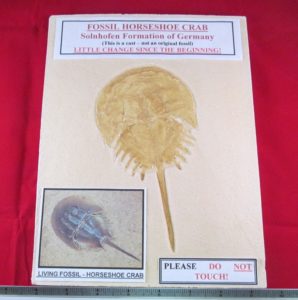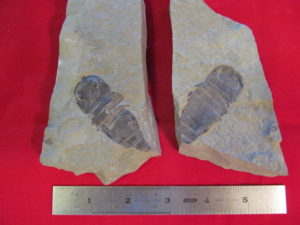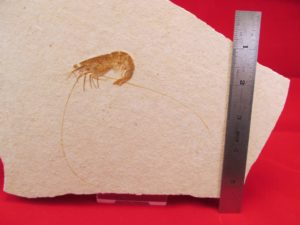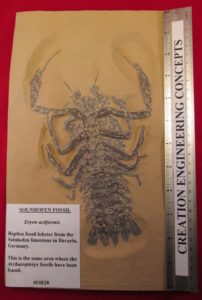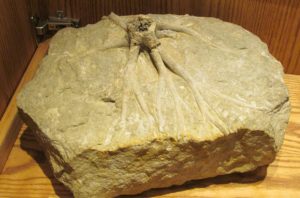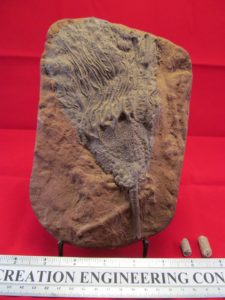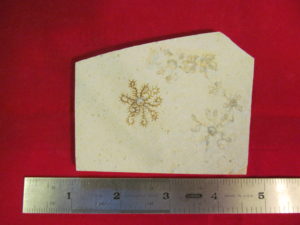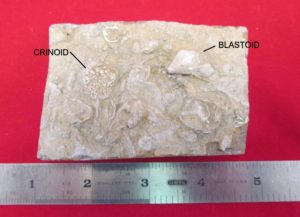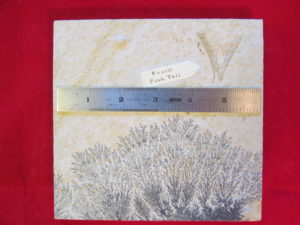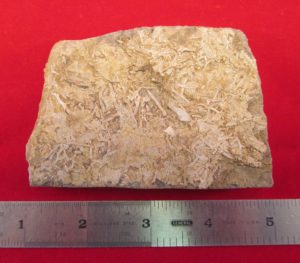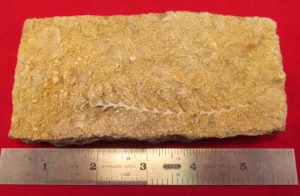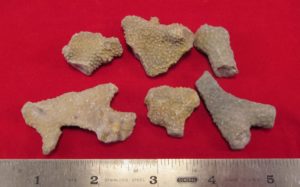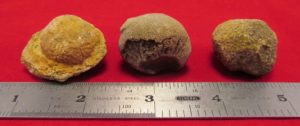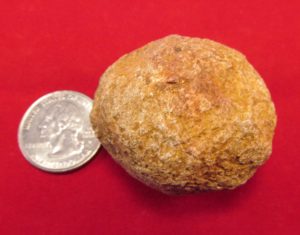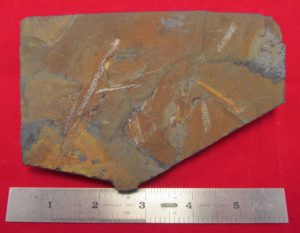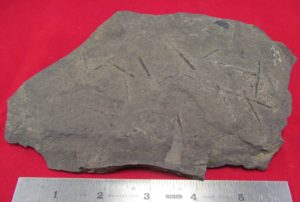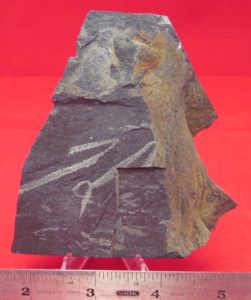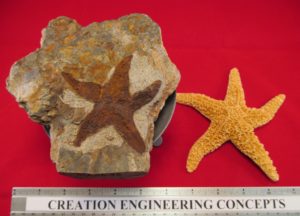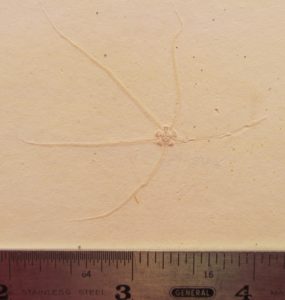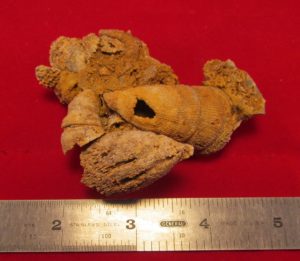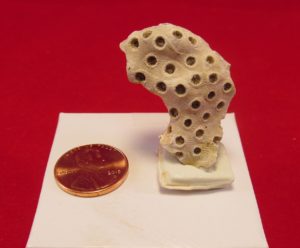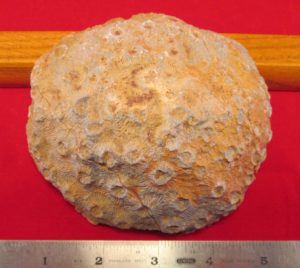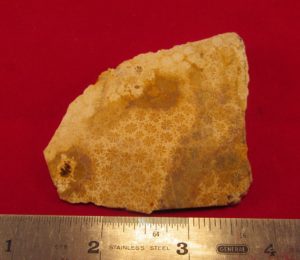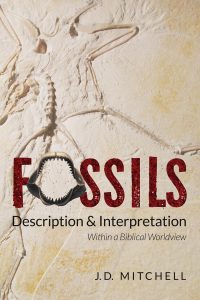All fossil images and descriptions ©2017 all rights reserved. Contact us for permission policy.
Horseshoe Crab Mesolimulus
Description: The replica Mesolimulus horseshoe crab is 3 3/4″ wide X 7″ long.
Location: Solnhofen limestone of Bavaria, Germany.
Interpretation: The horseshoe crab is a living fossil, meaning that it is the same in its fossil form as in its living form of today. This makes more sense if the fossils found in the rock record were buried in the cataclysmic worldwide Flood some 4,500 years ago, rather than the fossils having been buried hundreds of millions of years ago according to secular speculations.
There are literally hundreds of living fossil types that have been discovered in the rock record so far and these are strong evidence for the Genesis Flood and against evolution and millions of years. The horseshoe crab is an invertebrate animal which means it has no backbone.
#OR4
Sea Scorpion Eurypterus
Description: The Euypterus tail is 2″ long around the curve X 3/8″ wide maximum. Three complete thoracic segments, two partial segments and the tail spike make up this fossil.
Location: Bertie Waterline Dolostone group near Utica, New York.
Interpretation: Eyrypterus fossils are found in a number of locations in North America but are common in the Bertie Waterline group of New York State. As with many fossils they are usually incomplete and the majority represent molts of the animal. These sea scorpions are now extinct but probably lived a life similar to the horseshoe crab. Evolutionists consider Eurypterus to be primitive, yet it was likely just as complex as a horseshoe crab.
#MARF66
Sea Scorpion Balteurypterus
Description: The Balteurypterus fossil sea scorpion consists of a positive and a negative. The fossil is 2 1/4″ long X 1″ wide.
Location: Bagovitsa formation of Ukraine.
Interpretation: This invertebrate is similar in design to the more well known sea scorpion Eurypterus from New York.
#MARF93
Shrimp Antrimpos
Description: This aquatic arthropod is from the same area as the famous Archaeopteryx fossils. The Antrimpos shrimp body is 1 3/4″ long X 1/2″ tall. The antennae are about 4″ long.
Location: Solnhofen limestone near Eichstatt in Bavaria, Germany.
Interpretation: The Bavarian limestone quarries are similar to those near Kemmerer, Wyoming, and those in Lebanon, and many very intricate fossils have been recovered from each of these locations. For these fossils to have been preserved, they needed to be rapidly buried in lots of waterborne very fine sediment. Marine invertebrates like this shrimp are the most common fossil type found in the rock record that resulted from the actions of the Genesis Flood about 4,500 years ago.
#MARF31
Lobster Eryon
Description: Eryon lobster replica was fossilized upside down and its underside is visible. Two forward claws and eight walking legs with claws are also visible. The fossil is 8 7/8″ long X 5 7/16″ wide X 3/8″ thick. The lobster body is 6 1/2″ long X 2″ wide.
Location: The Solnhofen limestone of Bavaria, Germany.
Interpretation: According to evolutionists these Solnhofen fossils were made by a process of slow burial over hundreds of years. It is more likely that the reality is that the lobster was rapidly buried. Since this fossil is at least 3/8″ thick, it could not have been slowly buried over a period of years without disintegration. The author believes it was rapidly buried in the global Flood at the time of Noah.
The Decapoda order of crustaceans includes crabs, shrimps and lobsters. This complex fossil Eryon lobster is undoubtedly an ancestor of the lobsters living today. Differences between Eryon and modern-day lobsters are due to variations within the created kind allowed for by their DNA that was designed by God at the creation. God provided for this variation to allow lifeforms to adapt to a variety of changing living conditions. Variation within a kind is not “evolution” of one kind into another kind, and is in reality always limited.
#OR28
Crinoid Scyphocrinus
Description: The fossil crinoid is 4″ wide at the top X 7 3/4″ long with a 1/4″ diameter stem. There are two stem sections from another crinoid lying to the right of the Scyphocrinus crinoid. The image above is of a fossilized root system for a crinoid. These life forms are animals but look something like flowering plants and are often called sea lillies.
Location: The Scyphocrinus crinoid is from the Sahara Desert in Morocco.
Interpretation: Crinoids are flower-like (thus the name “sea lilies”) often beautifully colored invertebrate echinoderms, which grow in colonies on the sea floor. There are many genera identified from fossils in the rock record and also in the sea today. All crinoids have five-fold radial symmetry, but vary in shape, plates and arms.
“When crinoids die they disarticulate fairly rapidly, for within a few days of death the ligaments and soft tissues which hold the component skeletal elements together have decayed. Where a crinoid has been preserved intact (or nearly so) it would have been buried rapidly and with sufficient cover to avoid disarticulation of the component parts…”*
The above quote by evolutionary scientists matches the biblical creationist view, not only about crinoids, but also about the vast majority of other fossils. Crinoids were created in the beginning, many were buried in the Genesis Flood to be found later as fossils, and many still live today in the seas of the earth.
*Taylor, Paul D. and Lewis, David N., Fossil Invertebrates, Harvard University Press, 2005, p. 173.
#MARF32
Crinoid Saccocoma
Description: The Saccocoma fossil crinoid is 1″ outside diameter. There are five crinoids in the limestone matrix, but only one has been professionally prepared so its details can be seen. It has branched arms with a center globular cup.
Location: The Solnhofen limestone beds of Bavaria, Germany.
Interpretation: Probably the most common and inexpensive fossils available for beginning fossil collectors are the sections of stems from numerous genera of crinoid. These stem sections that formed the stalk that attached the crinoid to the sea floor are found fossilized by the millions. However, the Saccocoma crinoid is a stemless, generally free-living, crinoid. It has no stem to break into segments upon its death.
This genus of crinoid is very commonly found in the limestone at Solnhofen. Evolutionists understand that these delicate lifeforms could not have held together for long once they died. So, they have to imagine some sort of a sea bed devoid of oxygen, turbulence and scavengers to explain their fossilization. The biblical creationist imagines conditions during the year-long global Flood that rapidly buried them before they could disarticulate.
#MARF94
Blastoid Pentremites
Description: The blastoid rosebud is 3/8″ diameter X 9/16″ long and the crinoid remnant if 1/2″ diameter. These two identifiable fossils are embedded in a mass of other invertebrate fossil pieces.
Location: From the Bangor Limestone formation of northern Alabama.
Interpretation: Blastoids are small extinct echinoderms that were attached to the sea floor by a thin stem in a manner similar to the crinoids. The top “flower-like portion” is called the theca and often reminds one of a rosebud.
#MARF54
Pseudo Fossil Dendrite
Description: The dendrite mass extends 3 3/16″ high on the limestone slab matrix. The slab is 6 3/16″ wide. The “fish tail” is 1 1/2″ X 1 1/2″.
Location: From the limestone layers of Solnhofen in Bavaria, Germany.
Interpretation: Crinoids and blastoids look like flowers but are not. In the case of dendrites (from the Greek: dendron, meaning tree), they too look like plant fossils. But, they are not and never were organic. So when found in the rock record they are called pseudo fossils. Dendrites are especially common on limestone plates taken from Solnhofen, and were originally identified as fossils of moss-like plants. Dendrites really are mysterious inorganic structures composed of crystallized manganese (black) and iron (brown) compounds. The specimen shown here is made up of only the compound manganese dioxide. The creationist would say that dendrites are another wonderful handiwork of God!
The item identified as a fish tail is definitely a fossil, but it may not be a tail or even be from a fish.
#MARF4
Bryozoan Fenestella
Description: There are a number of disconnected lacy net like pieces of Fenestella in the limestone matrix. The zooid nets consists of tiny squares about 1/64″ in size. The stem-like pieces may be the spines that rooted the colonies to rocks or shells on the ocean floor.
Location: Bangor Limestone formation in northern Alabama.
Interpretation: Bryozoans are miniature colonial animals consisting of numerous connected individuals called zooids. Today they are found living in sub-tropical to cold water environments, but many of the bryozoan types found fossilized look to be extinct. Such is the case for the Fenestella genus. Bryozoans look like some corals but are more complex having nervous, muscular and digestive systems.
These tiny animals can be seen with the naked eye but are best studied under a microscope in order to see the fine detail of their construction. When man-made things are examined with microscopes, they lose detail in proportion to the amount of magnification. God’s creations, on the other hand, continue to show wonderful design with the largest magnifications. (Left click twice on the image to see more detail.) The Law of Biogenesis and common sense tell us that even these relatively simple animals have great complexity and did not evolve from inorganic materials.
#MARF55
Bryozoan Archimedes
Description: The Archimedes structure is 3 3/8″ long X 1/4″ maximum diameter. There are 15 visible threads in the fossil. If you double click on the image you will be able to see crinoid stem sections and Fenestella bryozoan net parts in the matrix as well.
Location: Bangor Limestone formation in northern Alabama.
Interpretation: This wonderful bryozoan animal was undoubtedly named after the Archimedes screw developed by man thousands of years ago to pump irrigation water. Many human inventions may have been inspired by the works of God found in nature. It is possible that an Archimedes bryozoan or another of God’s similar designs inspired the first Archimedes screw.
#MARF56
Bryozoan Constellaria
Description: All six specimens have hundreds of bumps (monticules) that are characteristic of the Constellaria byrozoan genus from Kentucky. Specimens tend toward the branching design rather than the massive or encrusting types. The feeding zooids would have lived in the monticules. The largest bryozoan in the photo is 2″ X 1 3/16″ X 3/16″ thick. The smallest is 1″ X 7/8″ X 3/16″ thick.
Location: Kentucky.
Interpretation: Constellaria genera from other areas of the world are somewhat different from the ones shown here from Kentucky. They often have star-shaped monticules. This is an indication of variation that occurred within this byrozoan kind between the time of the creation and the Flood.
#MARF68
Sponge Astylospongia
Description: All three sponge fossils are basically spherical in shape. They are all about 1″ diameter. Some of the internal structure can be seen in the center specimen.
Location: The Beech River formation in Tennessee.
Interpretation: Evolutionists characterize sponges like Astylospongia as simple or primitive animals. However, man cannot make sponges that would live as do the ones created by God. Sponges are very complex with multi-cells of different designs that can capture food particles, derive nourishment from the food, and then expel the waste. They must have some sort of skeletal system as well, usually consisting of complex needle-like spicules.
The reason for the emphasis by evolutionists on the idea of “simple” life is that they must convince the gullible that life somehow came from non-life. However, the Law of Biogenesis specifies that life can only come from life. This is called a law of nature because it has never been observed to fail. We know that some types of sponges are alive today, and probably have always existed as such since creation.
#MARF70
Sponge Hindia
Description: The Hindia fossilized sponge is nearly spherical and is about 1 1/4″ X 1 5/8″.
Location: From the Beech River formation in Henderson County, Tennessee.
Interpretation: Evolutionists have placed sponges in the phylum Porifera where they have not been able to identify any common ancestors. That is, they believe sponges have existed ever since the “explosion of life” (Cambrian) with their supposed ancestors not found anywhere in the rock record.
The Hindia fossil sponges have left no evidence that they were attached to anything while alive like so many other sea animals. Perhaps they were designed to roll freely about on the sea floor. At any rate, the fossil record for sponges aligns with the biblical creationist view that sponges were created by God in the beginning to be sponges.
#MARF71
Graptolite Phyllograptus
Description: The longest Phyllograptus stipe is 1 3/4″ long and the widest stipe is 1/4″ wide. The shale matrix is 5 1/2″ wide X 3 11/16″ high X 1/2″ thick. The tubular stipes are all flattened onto the shale, but thecae can clearly be seen by double clicking on the image.
Location: Toyen formation near Oslo, Norway.
Interpretation: Graptolites are fossilized marine colonial organisms with each colony having one or more tubular branches (stipes). It is thought that most of these extinct organisms floated on the oceans among the plankton they are thought to have fed on. The stipes bore numerous cup-like structures called thecae that housed the individual animals called zooids, similar to those in corals and bryozoans.
Evolutionists consider graptolites to be part of their imagined long macroevolutionary trek of “goo to you.” That is, they consider graptolites as in the evolutionary line to the vertebrates. But there is no known common ancestor for them and since they seem to be extinct, no evolutionary link to the next advanced step of life.
The biblical creationist could hypothesize that graptolites were created by God in the beginning as graptolites, and then went extinct due to conditions during and/or after the global Flood. There is no way to experimentally test any extinction hypothesis for these graptolites because the conditions of the Flood cannot be repeated today.
#MARF83
Graptolite Monograptus
Description: The longest Monograptus stipe is 2 1/4″ long and the widest stipe is 1/16″ wide. All stipes are straight with theca visible to one side only.
Location: The Bardo syncline, Holy Cross Mountains, Poland.
Interpretation: The Monograptus genus of graptolite fossil is always found with a single branch and with the thecae running on one side only. However, Monograptus stipes can be found straight, gently curved, or even spirally twisted. These fossils are geologically important because they are defined as index fossils.
To the biblical creationist, index fossils can be useful for helping to determine which types of fossils, minerals, or elements are often found together in the sedimentary layers of the rock record. While the secular scientist may think an index fossil determines the age of a particular batch of rocks, this is not reality. Instead it is only circular reasoning because the ages of index fossils are a priori assumed to be of a certain age according to the geologic timeline which is simply a mental abstraction. The most common index fossils are marine invertebrates for all stratigraphic layers, which makes sense because marine invertebrates make up the vast majority of all fossils.
#MARF87
Graptolite Didymograptus
Description: The longest Didymograptus stipe is 1 3/4″ long and the maximum stipe width is 5/32″ wide. All thecae run along the insides of the stipes and are shaped like saw teeth. The angle between the stipes is 15 degrees on the left specimen and 30 degrees on the right specimen.
Location: From Dyfed, Wales, United Kingdom.
Interpretation: Didymograptus is identifiable by its tuning fork shape, but it is not known how the extinct graptolite colonies would have oriented themselves in the ocean waters. It is also not known how the zooids that are assumed to have inhabited the thecae looked or operated. The location on each graptolite where the stipes originated is called the sicula. Experts believe that while the stipes and theca are always flat as fossils, they must have been 3-dimensional when living.
Since graptolites are currently understood to be extinct, it is not possible to know as much about them as would be possible if they were still living. Nevertheless, to the biblical creationist their complex and amazing design indicates a Designer rather than a common ancestor.
#MARF88
Starfish Stenaster
Description: The fossil starfish Stenaster fits inside a 3 1/4″ diameter circle and is up to 1/8″ thick. Fine exterior original markings are visible on three of the five arms. Matrix is 5″ X 5 1/2″ X 1 1/2″ thick. The recent starfish to the right fits inside a 5 3/4″ diameter circle and is 3/4″ thick.
Location: From Morocco.
Interpretation: Experts have identified scores of species names for fossil and extant starfish (Asteroids) and oftentimes do not agree on the proper genus/species for them. Asteroids are often defined as having five arms broadly connected to the central body and looking like a five-pointed star. Asteroid invertebrate animals have a mouth that is located on the underside in the middle. These descriptions match both starfish in the photo.
The two starfish are displayed next to each other to highlight the close similarity in shape and design. If they should prove to be the same in other aspects of construction then Stenaster and the common (or sugar) starfish could be the same genus and be a living fossil.
#MARF35
Brittle Star Geocoma
Description: The Geocoma center disc is 3/16″ diameter and the five fragile arms extend to form a circle about 2″ in diameter. Double click the image to see the detail of the arms and the segments that make them.
Location: Solnhofen limestone of Bavaria, Germany
Interpretation: This fossil was recovered from the same type of fine limestone in which several of the famous Archaeopteryx specimens were found. The matrix is so fine that amazing detail in fossils can be seen such as the detail of construction of this very fragile brittle star.
The arms and center disc of brittle stars (Ophiuroids) are much different from those of starfish (Asteroids). The Geocoma fossil brittle star seen here is very similar to some existing brittle stars that inhabit the ocean floors in vast masses today. When fossil brittle stars are recovered they too are often found in vast quantities.
#MARF3
Coral Heterophrentis
Description: These Heterophrentis animals were once cone-shaped and lived a solitary life. On the exterior they had long longitudinal ridges and encircling growth lines. The largest horn coral specimen in the image is 1″ diameter X 2″ long. The complete fossil conglomerate is 2″ wide X 3″ long X 1″ thick. The matrix consists largely of numerous coral fragments and other unidentifiable matter.
Location: The Jeffersonville limestone of Indiana.
Interpretation: Secular scientists describe coral as “simple” lifeforms. Yet they are complex beyond man’s ability to duplicate or create them from nothing. The biblical creationist is able to appreciate the works of the Great Designer.
#MARF45
Coral Astrhelia
Description: The Astrhelia coral fossil has exterior small circular calices nearly evenly spaced. The calices are 1/16″ to 1/8″ diameter with approximately thirty calices per square inch. The fossil is 1 1/2″ tall X 3/4″ wide X 1/2″ thick. The surface, septa and calices are all sharp with very little water wear.
Location: Calvert County in Maryland.
Interpretation: This particular genus of coral is categorized as a recent evolutionary development by evolutionists. But from what did it evolve? This question is a common problem in evolutionary theory for many kinds of plants and animals. These corals and similar kinds have not been found deep in the sediments and so the evolutionists must assume they have an unknown ancestor.
When the biblical creationist looks at this specimen he sees tremendous design and much microscopic detail. These attributes do not come from the random-chance interaction of matter. They do result from the intentional application of knowledge by an intelligent mind. We know men did not create this coral design so it makes sense that God did, as we are told in the Bible! The biblical creationist agrees that there is variation within created kinds, but this variation is always limited.
#MARF59
Coral Colony Phillipsastrea
Description: The corallites on the surface of the coral colony are round to irregularly-shaped polygons and vary in size from 1/8″ to 1/4″. There are about six corallites per square inch of surface. The Phillipsastrea coral colony is 4″ X 4 1/2″ X 1 1/2″ thick.
Location: From Morocco.
Interpretation: According to secular thought, these fossilized colonies of coral are millions of years old. Yet, similar coral colonies exist today. Why don’t they fossilize by the billions? The reason is that fossilization almost always requires the special conditions of rapid burial under large amounts of sediment-filled water. Those are the unique conditions of the Genesis Flood, a one-time-in-history event.
#MARF49
Coral Colony “Chrysanthemum”
Description: The corallites are about 3/16″ diameter with about 25 corallites per square inch. The slab is 2 1/2″ X 2 1/2″ X 7/16″ thick.
Location: From Taiwan.
Interpretation: Various genera of fossilized colony-type coral from all over the world are sliced, cut and polished into beautiful cabochon pendants and jewelry. Besides Chrysanthemum seen here, another popular coral stone for these purposes are the Petrosky stones (Hexagonaria) from Michigan.
How amazing is the natural beauty of millions of created things God has provided, including fossils from the worldwide Flood!
#MARF50
ORDER THE FOSSIL BOOK:
